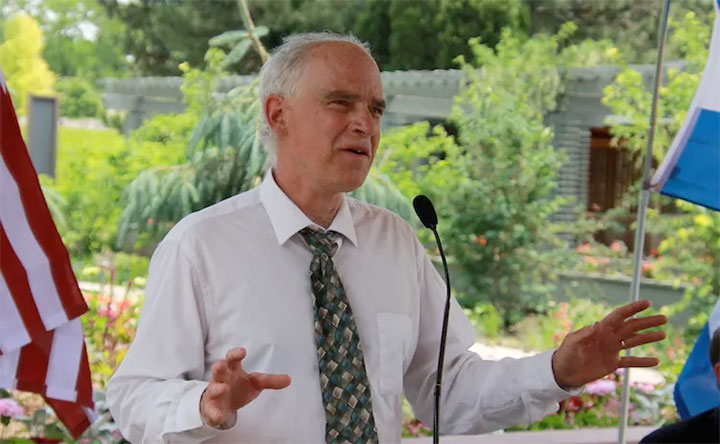PHOTO: The existing Pawnee coal plant would be reconfigured to burn hydrogen to create electricity. New research, however, warns that hydrogen production could be a step backward.
This story by Allen Best appeared on BigPivots.com on April 14, 2023 as “Hydrogen: high hopes but also skepticism. We’re sharing it in two parts.
Colorado’s greatest hope in securing federal aid to lay the foundations for a hydrogen economy lies at Brush, 90 miles northeast of Denver.
There, Xcel Energy proposes to modify the Pawnee power plant to use hydrogen to fuel the existing steam boiler. The hydrogen is to be created from wind and solar generation, augmenting the natural gas that within a few years will replace coal now burned to produce the steam that then generates electricity.
That detail can be found in an otherwise heavily redacted concept paper submitted to the U.S. Department of Energy in November 2022 in a bid to secure $1.25 billion in federal funding for research and development of hydrogen in Colorado and three adjoining states. The project is called the Western Interstate Hydrogen Hub LLC.
Both Xcel and Colorado state government issued press releases this week announcing that the states — New Mexico, Wyoming, and Utah, in addition to Colorado — had submitted their application.
Some environmental advocates remain wary. They point to research from Princeton University and the National Oceanic and Atmospheric Association that suggests hydrogen’s potential as a clean fuel could be limited by a chemical reaction in the lower atmosphere.
The research found that above a certain threshold, even when replacing fossil fuels, a leaky hydrogen economy could cause near-term environmental harm by increasing the amount of methane in the atmosphere.
“We have a lot to learn about the consequences of using hydrogen, so that the switch to hydrogen, a seemingly clean fuel, doesn’t create new environmental challenges,” said Amilcare Porporato, a professor of civil and environmental engineering at Princeton.
The federal funding for hydrogen hubs was announced by the Department of Energy last September. Altogether, $7 billion will be available for 6 to 10 hydrogen “hubs” across the United States. The money comes from an allocation of $8 billion in the Bipartisan Infrastructure Law that was passed by Congress in 2021.
U.S. Secretary of Energy Jennifer M. Granholm in September described the hubs as a “once-in-a-generation opportunity to lay the foundation for the clean hydrogen future President Biden is building—one that will lift our economy, protect the planet, and improve our health.”
Will Toor, the director of the Colorado Energy Office, was only slightly more circumspect in his language when I talked with him this week. He said he has a measure of confidence Colorado and neighbors will get chosen. In that case, an electrolyzer will be installed in the middle of this decade and production will be ramped up over time.
An electrolyzer uses electricity to split water into hydrogen and oxygen. Colorado’s proposal emphasizes use of renewables as the source of electricity.
Can hydrogen scale as a technology? That depends, at least in part, upon whether the cost curve can be bent down.
“I think the combination of technology improvements and the economic course created by the production tax credits for hydrogen in the Inflation Reduction Act of 2022 has given a significant boost to making it possible to deploy hydrogen at a meaningful scale,” said Toor.

Hydrogen is not the only way forward with the energy transition, he said, but rather one of several potential paths to move forward into a deeply decarbonized economy.
The Colorado Energy Office sees hydrogen as being among a suite of emerging technologies along with advanced geothermal and carbon capture that could potentially become deployed at meaningful scale, he said. But all have uncertainties, including cost trajectories that will influence how effective these technologies will be.
“We see them as important tools in the tool box to achieve deep decarbonization. What we are doing is creating an environment to enable early deployment from which we will learn about the cost trajectories and scaling potential over time. I think it’s premature to pick technological winners and losers. There is a suite of technologies that we need to start moving forward on, over time. I think we will see which ones are able to scale,” Toor said.
What if the proposal by Colorado and its neighbors gets rejected?
Toor says he sees this outcome, if unlikely, as still a useful exercise because it caused Colorado and its neighbors to work together and interact with the private sector on potential hydrogen projects.
“It is up to us to clarify the hydrogen opportunities in the region. And I think we are very optimistic about being chosen for regional hydrogen hub funding, which would be a major boost,” he said. “But I think we will see momentum on clean hydrogen regardless of the outcome.”
The eight specific proposals submitted in the package vary substantially in their configurations. In New Mexico, for example, the Navajo Agricultural Production Industries plans to convert its farming operation to operate on hydrogen fuel, including all major farm equipment. In Utah, Dominion Energy proposes to begin high-pressure blending of hydrogen with methane, with the intent of producing synthetic natural gas, by 2027.
Allen Best publishes the e-journal Big Pivots, which chronicles the energy transition in Colorado and beyond.
